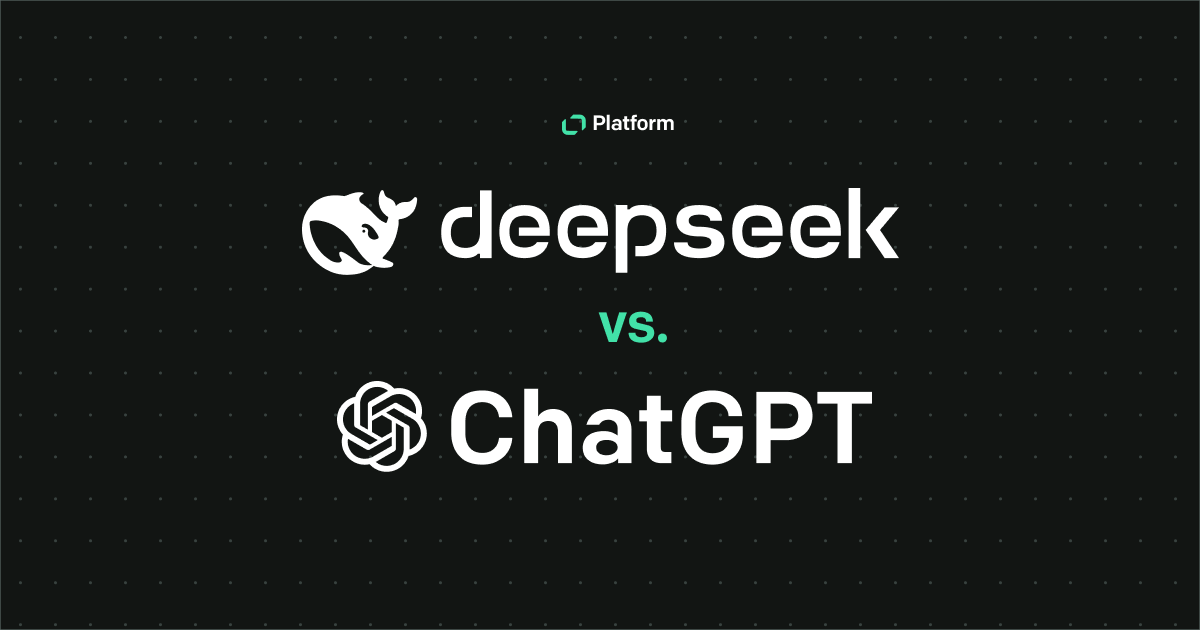In 2025, to be a successful developer, you must leverage AI effectively. Artificial intelligence (AI) is completely changing how developers write, debug, and maintain code. Thanks to AI-powered tools, the coding process is becoming more efficient, error-free, and accessible to a broader range of people, including those new to programming.
AI code can now be found in most recent software deployments, as organizations and developers find the improved code quality and faster development timelines too valuable to pass up. If you aren't using an AI tool during development, maybe now is the time to start.
Why do developers need AI tools?
The role of software developers has evolved significantly over the last 20 years. Once narrowly defined by the ability to write and debug code, developers are tasked with a wider array of critical functions. Today, developers are recognized as a key part of the entire product lifecycle, from initial concept to deployment and security. To put it simply, the expectations have changed.
While this change has been a major factor in developing much more robust, powerful, and innovative software, it places additional strain and challenges on the developers themselves. It has become necessary for developers to find new ways to manage their increased workload without compromising on quality or efficiency.
This is where AI tools and AI-powered tools come into play.
AI tools are designed to assist developers in various aspects of their work, making it possible to write code faster and enhance code quality at the same time. The AI tools for developers can suggest entire lines of code or perform tasks that would typically consume a considerable amount of time. This speeds up development processes and improves the coding experience by automating repetitive tasks. Developers can then focus on more complex or creative aspects of their projects.
Universal features of AI tools
While different AI tools for developers come with different features and capabilities, most are designed with flexibility in mind. This means they support multiple languages, enabling a wide range of developers to benefit from AI assistance in their preferred coding language.
To prevent the disruption of familiar development workflows, most tools also seamlessly integrate with popular integrated development environments (IDEs) and code editors, such as Visual Studio Code.
AI-powered coding assistants
Coding assistants embed AI directly into the development process. This enhances productivity, ensures code quality, and improves developer satisfaction. These tools utilize advanced machine learning (ML) models to understand code context, predict developer intentions, and provide support in writing code, debugging, and documentation. Key features include:
Context-aware suggestions
These assistants analyze the developer's current coding environment – the code they've written, comments within the codebase, and prevalent coding patterns in the project – to provide context-aware relevant code suggestions.
Imagine a developer is working on a feature that involves database interactions. Because the AI assistant considers the context of the current task, it might offer suggestions related to optimal query structure or error handling specific to the database being used.
Code completion
With real-time, intelligent code completion integrated directly into the code editor, AI can drastically reduce the developers' time writing standard code structures or repetitive tasks. This feature predicts the next lines of code based on the initial input, helping developers complete functions or even entire blocks within a single click.
This has existed in some basic form within code editors for a while now but has improved considerably with the addition of AI algorithms and context awareness.
Code generation
Developers can input natural language descriptions for what they want into AI coding tools with pre-trained models. The tool can then generate code snippets covering various programming languages. For instance, a developer could describe a feature as "create a REST API endpoint for fetching user profiles," and the coding assistant would produce a scaffold of the necessary code built in the project's specific language.
Natural language explanations
AI tools can leverage the capabilities of large language models that are pre-trained on vast datasets of code and documentation through natural language processing (NLP). They can provide a code explanation in natural language, making it easier for developers to understand unfamiliar or complicated code. This is especially beneficial for learning or onboarding new team members.
Documentation generation
Maintaining accurate and up-to-date documentation is a challenge for many development teams. AI-powered coding tools can automatically generate documentation for existing and newly written code. This allows the documentation to keep pace with development, simplifying maintenance and scaling.
Top 5 AI-powered coding assistants
1. GitHub Copilot
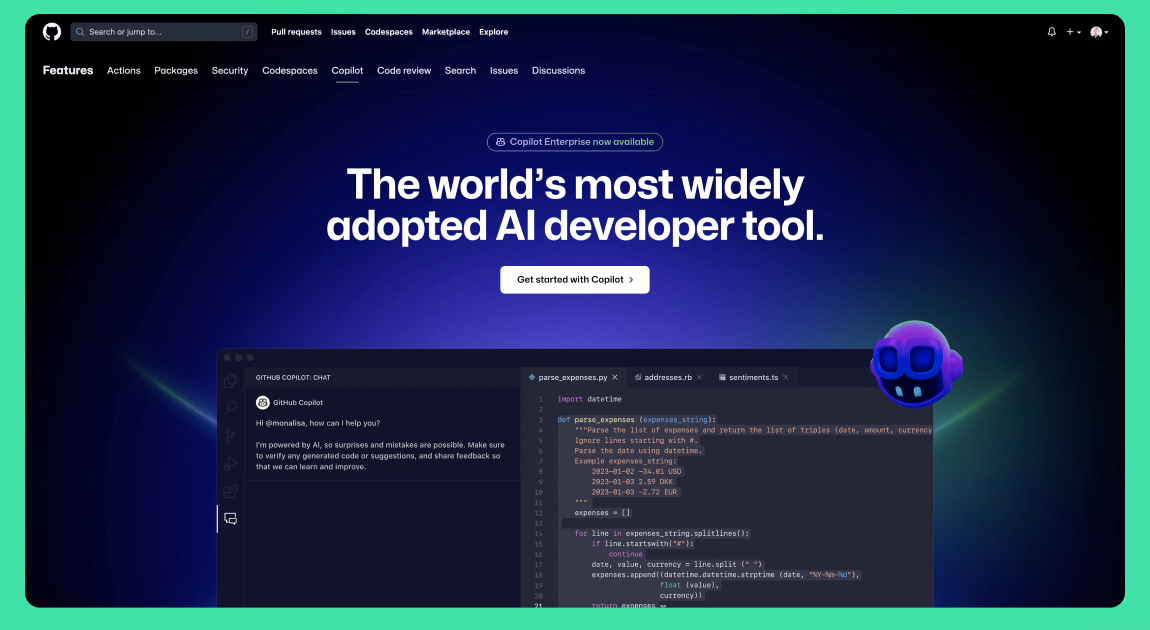
Pair programming at scale – Acts like a virtual pair programmer, suggesting not just snippets but whole blocks of code, including complex algorithms and test cases, based on the context provided by comments or code.
Niche language support – While GitHub Copilot supports multiple popular languages, its unique strength lies in its ability to understand and generate code in less common languages and frameworks.
2. Tabnine
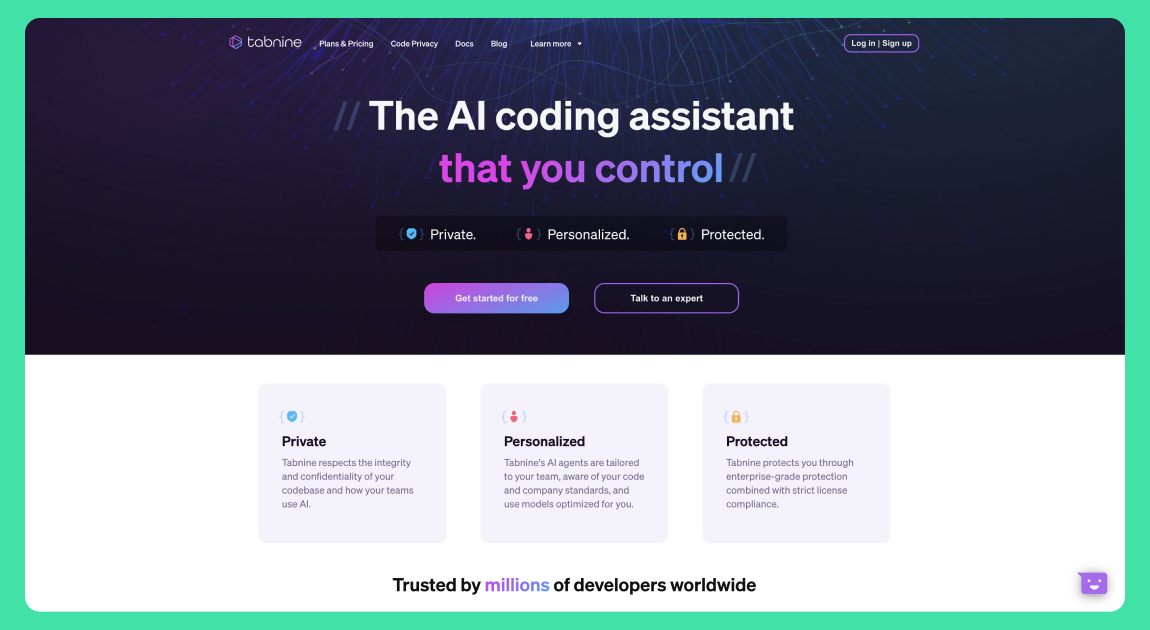
Personalized code completions – Unlike other tools, this tool supports a personalized experience by adapting its suggestions based on the individual developer's coding style and the specific codebase it's trained on.
Local and cloud models – Offers a unique dual-model approach where developers can choose between cloud-based models for the most up-to-date intelligence and local models for privacy-sensitive projects.
3. Replit AI
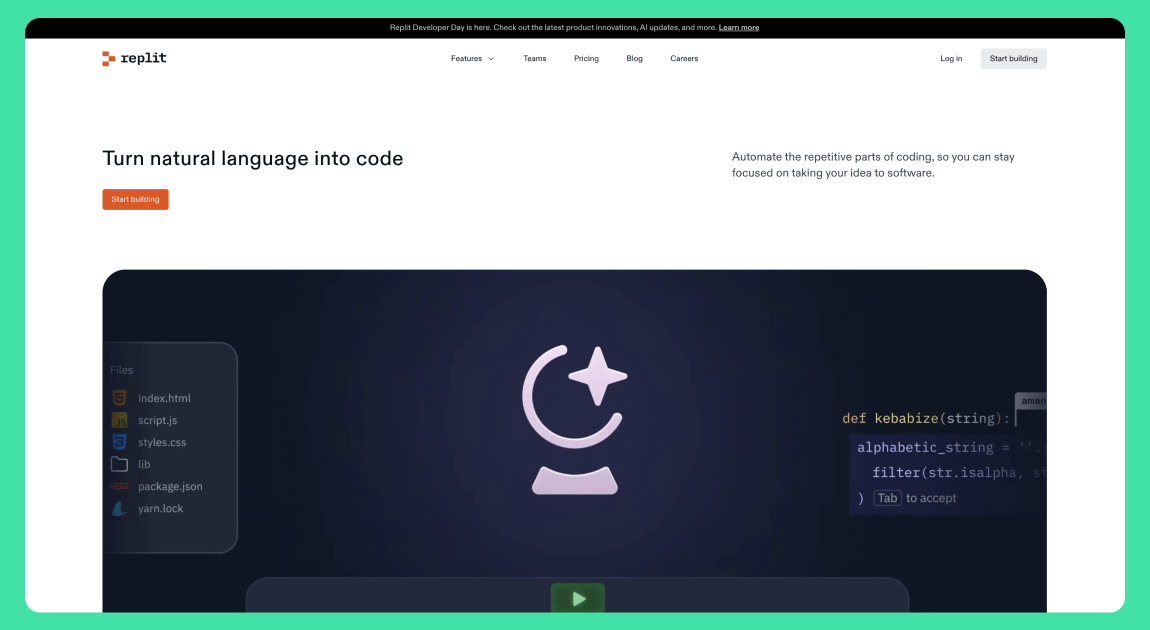
Integrated online IDE – A web-based tool that lets developers access advanced AI coding capabilities directly within their browser.
AI chat – Natural language processing allows developers to have a conversational interaction without leaving the IDE. Developers can generate code, get code explanations, and solve coding challenges through a simple chat interface.
4. Cody by Sourcegraph
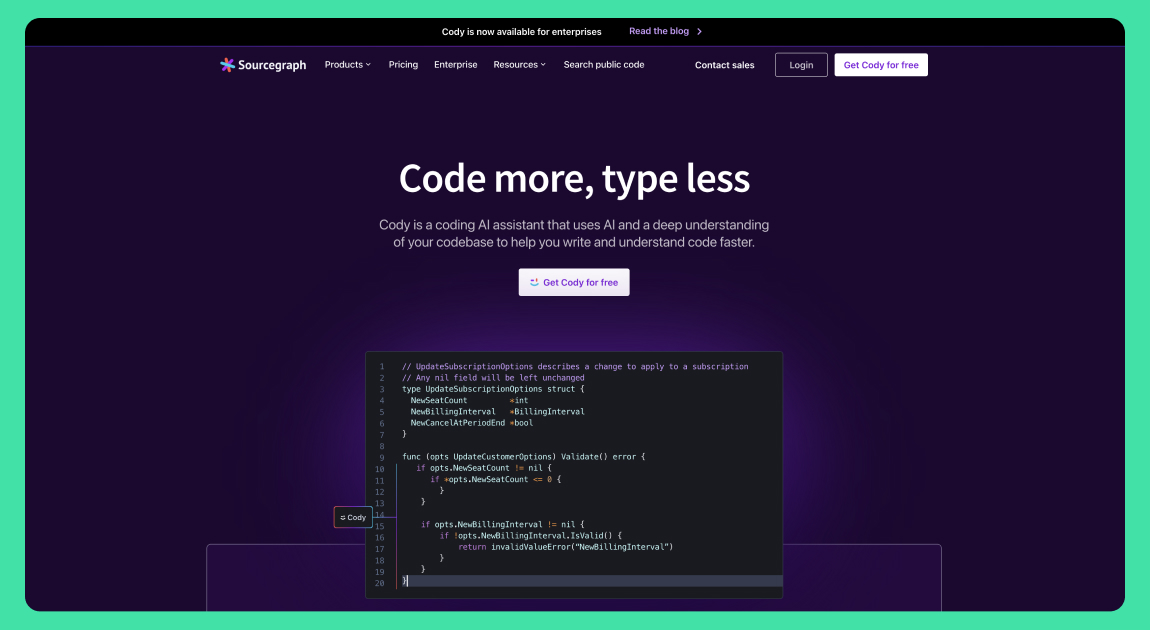
Code unblocking – Designed to unblock developers by answering specific questions about the codebase, such as the repository structure, the purpose of a file, or the definition of a component.
Custom and pre-built commands – Offers code testing, fixes, and optimizations through a series of one-click commands. Developers can define their own custom commands to fit their workflow.
5. Amazon CodeWhisperer
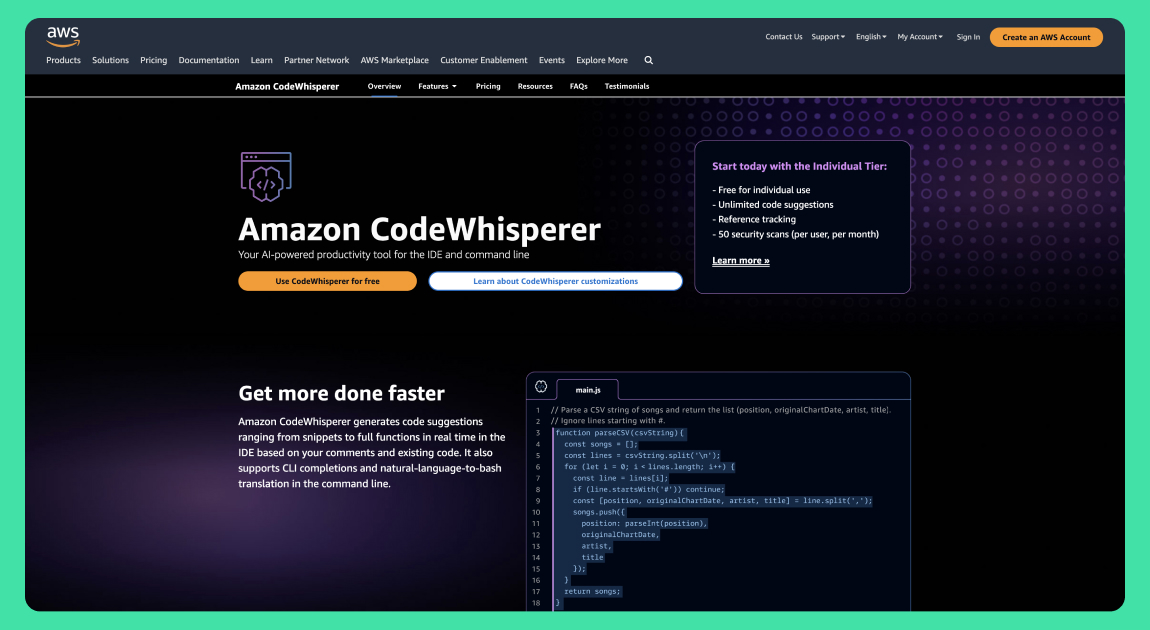
Security and best practices – Provides real-time recommendations for security best practices and flags potential security vulnerabilities as you code, a critical feature for developing secure applications in today's environment.
Integration with AWS services – Designed to integrate with the AWS ecosystem, making it a standout choice for developers heavily invested in AWS services. It even offers tailored suggestions for AWS API calls and services.
AI for debugging and testing
Debugging and testing are one of the most intensive parts of the software development life cycle. Traditional approaches require developers to manually craft and execute tests, a process that demands significant effort and expertise and introduces the potential for human error. When it's time to fix bugs, AI is a valuable tool. Key features include:
Automated bug and anomaly detection
Automated bug detection employs machine learning models to analyze code for patterns known to be problematic, drawing on extensive databases of historical bug data (public bug tracking systems, GitHub repositories, etc).
Anomaly detection operates on the application's runtime behavior to identify deviations from expected forms. This method watches key performance indicators to understand what typical performance looks like. With this information, the AI model can identify anomalies like memory leaks or unexpected latency spikes.
Error detection and suggestions
Through real-time analysis, AI development tools can identify errors or potential bugs as they are coded, offering corrections on the fly. This preemptive approach to debugging code saves time and improves the quality of written code.
For example, if a developer accidentally wires a loop that fails to properly release database connections, the coding assistant would quickly identify the potential for a memory leak within the loop. It would then alert the developer to the issue and offer a specific suggestion to refactor the loop.
Security vulnerability identification
Artificial intelligence can systematically scan codebases for patterns known to be vulnerabilities or unsafe coding practices that pose security risks. It leverages databases of known vulnerabilities, like the Common Vulnerabilities and Exposures (CVE) list. When a match is found, the system can identify the vulnerability and suggest specific remediation steps.
Top 5 AI tools for debugging and testing
1. CodeAI
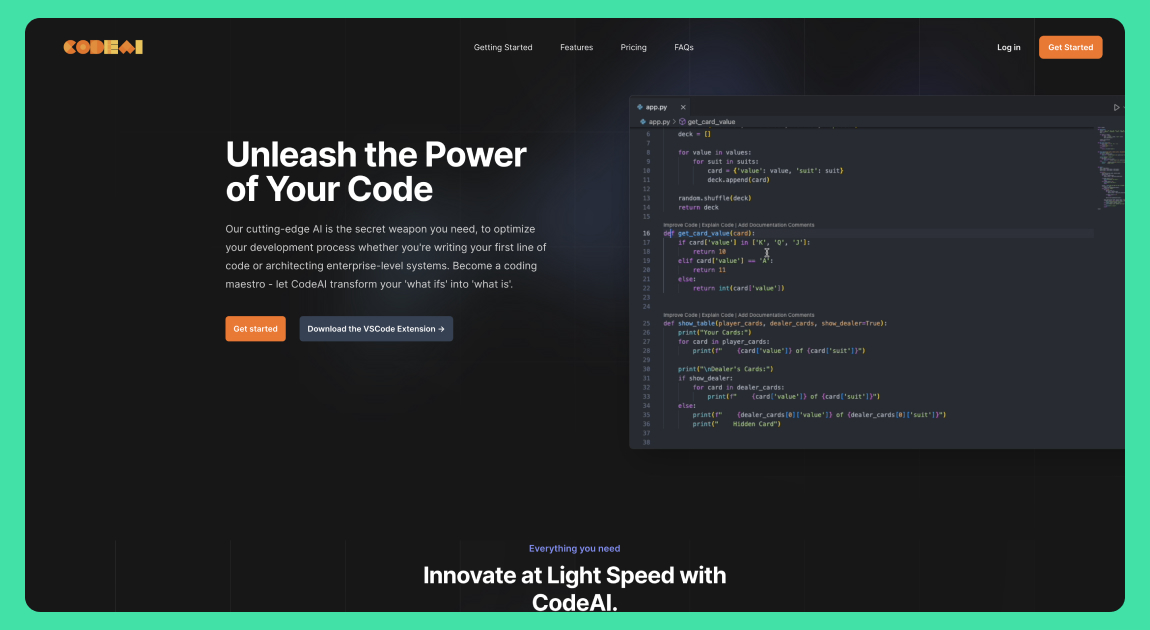
Smart fix suggestions – Unlike basic bug detection tools, CodeAI identifies issues and suggests precise fixes that developers can apply with confidence.
Broad language support – It offers comprehensive support across multiple programming languages, enabling it to serve a wide range of projects and development teams.
2. DeepCode AI (now Synk)
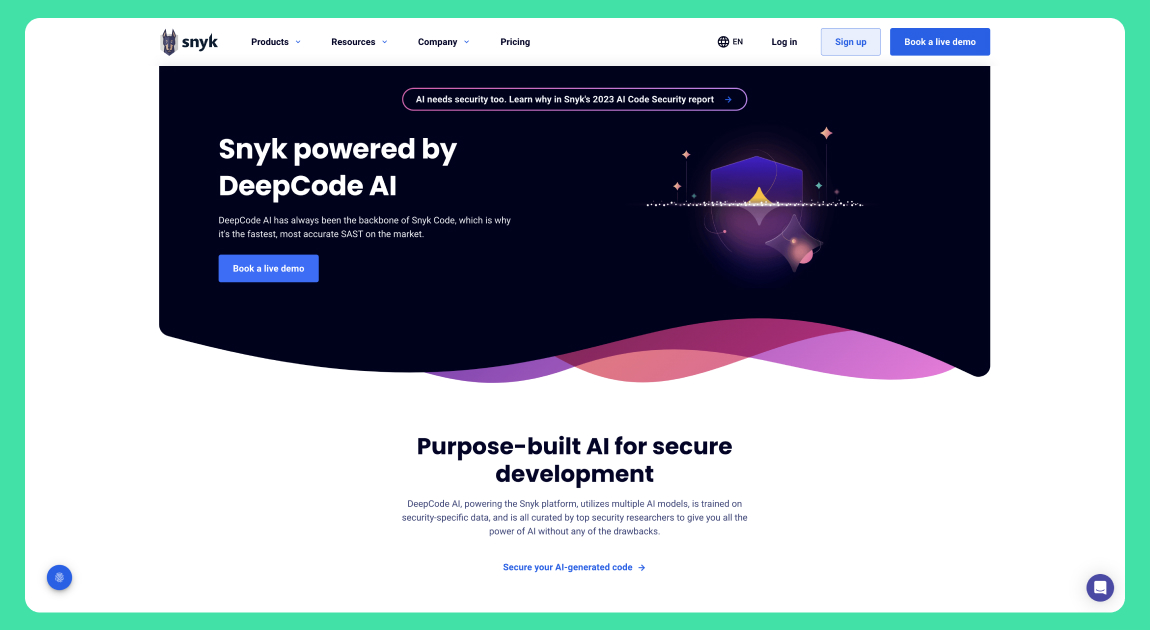
Semantic code analysis – Can perform semantic analysis on code, going beyond syntactic checks to understand the intent behind code constructs. This deeper understanding allows DeepCode to catch subtler bugs that traditional linters might miss.
Community-driven insights – Leverages insights from the active community and open-source contributions, enriching its database with real-world coding patterns and emerging bug types.
3. GitLab's Code Quality Tool
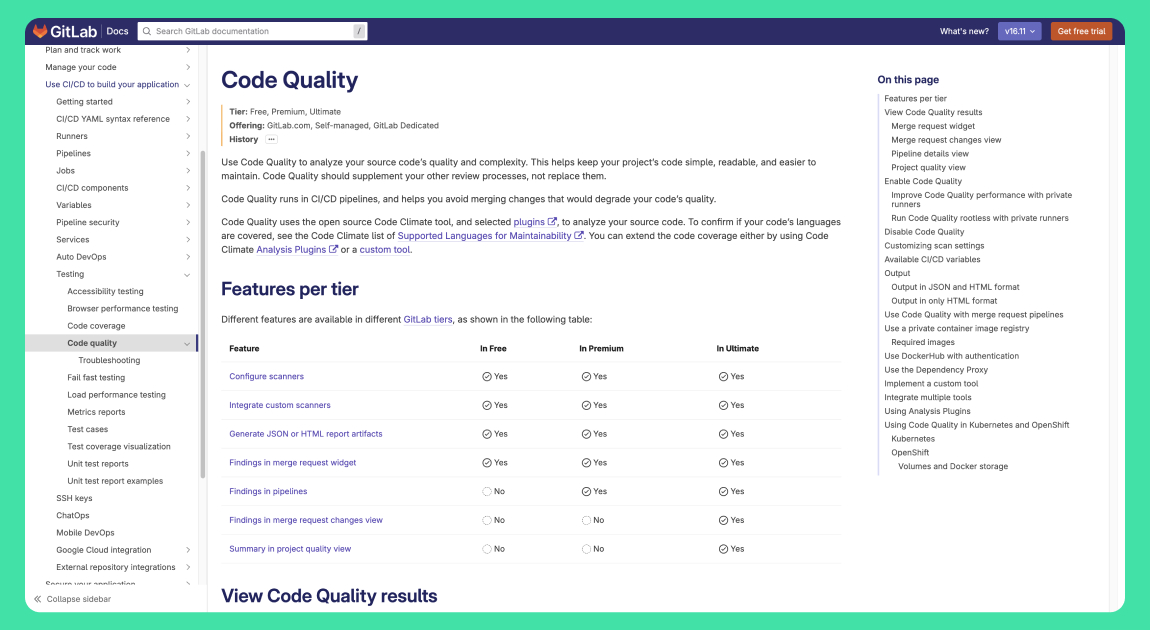
Integrated development experience – Provides a fully integrated experience within the GitLab platform, offering quality reports directly in merge requests to catch issues before they're merged into the main branch.
Customizable rules – Allows teams to define custom rules for quality checks, ensuring that the tool aligns with the team's specific coding standards and practices.
4. Selenium

Visual testing – Enables visual testing of web applications to help developers create high-quality, responsive websites. This approach allows for the detection of visual regressions and UI anomalies that might not be caught by standard automated tests, ensuring that the application looks as intended across different devices and browsers.
Dynamic element handling – Can interact with dynamic web elements. This reduces test flakiness caused by UI changes, a common challenge in web application testing, ensuring more stable and reliable test execution.
5. SonarQube
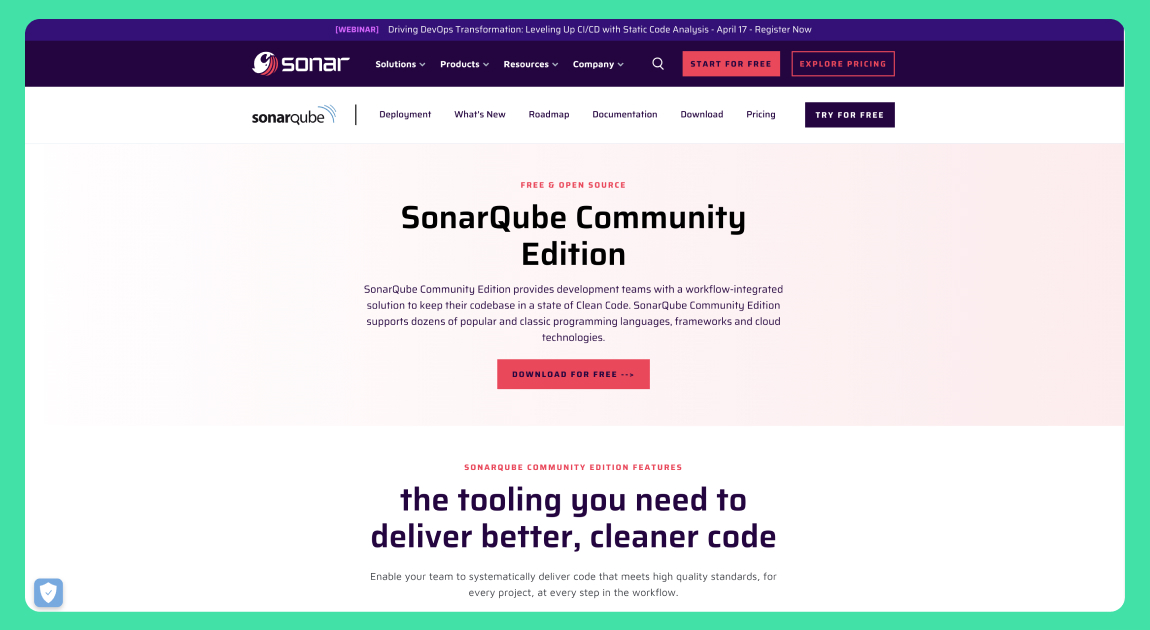
Continuous inspection – Offers a continuous inspection service that integrates with CI/CD workflows, automatically scanning code for bugs, code smells, and security vulnerabilities with each push to the repository.
Rich dashboard and reporting – Features a user-friendly interface with comprehensive dashboards and detailed reports that give teams visibility into the health of their codebase, making it easier to track improvements over time.
Code optimization and refactoring tools
Code optimization and refactoring tools with AI capabilities are equipped to dig into the codebase and offer actionable insights and suggestions to developers. They identify syntax errors or stylistic inconsistencies and aim to enhance the structural integrity of code – creating all-around better code. Key features include:
Static analysis
This scrutinizes the code without executing it to identify potential issues like syntax errors, logic errors, type mismatches, and even security risks. This tool is valuable for enforcing coding standards and consistency across a large development team.
Tools like Checkstyle for Java can be configured to match an organization's specific coding conventions, automatically flagging deviations such as mismatched naming conventions or improper bracket use.
Automated refactoring suggestions
These can automatically suggest opportunities to eliminate redundant code, improve code structure, and enhance readability without changing the code's external behavior. For example, this might involve alterations to class hierarchies to promote code reuse or propose the division of monolithic functions into smaller, more focused functions that are easier to manage and test.
Performance optimization
By analyzing the execution paths and resource usage patterns, these tools can identify potential bottlenecks and suggest code modifications that improve performance. This might include optimizing loops to decrease execution time or reducing memory consumption by altering data structures.
Top 5 AI tools for code optimization and refactoring
1. Sourcery
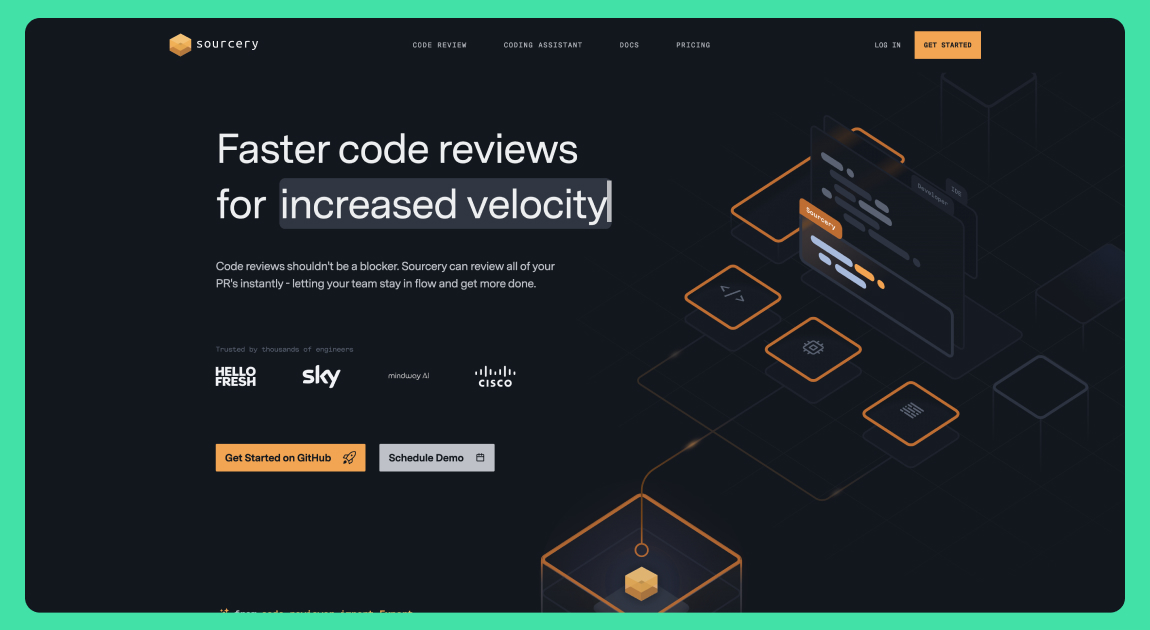
Instant refactoring feedback – Provides instant feedback directly in the code editor, allowing developers to see and apply refactoring suggestions with just one click. This feature is particularly helpful for iterative code improvement and learning best practices in real time.
Refactoring metrics – Uses specific refactoring metrics, such as cyclomatic complexity and method length, to suggest targeted improvements. It actively identifies sections of code that can be made more concise.
2. Visual Studio IntelliCode by Microsoft
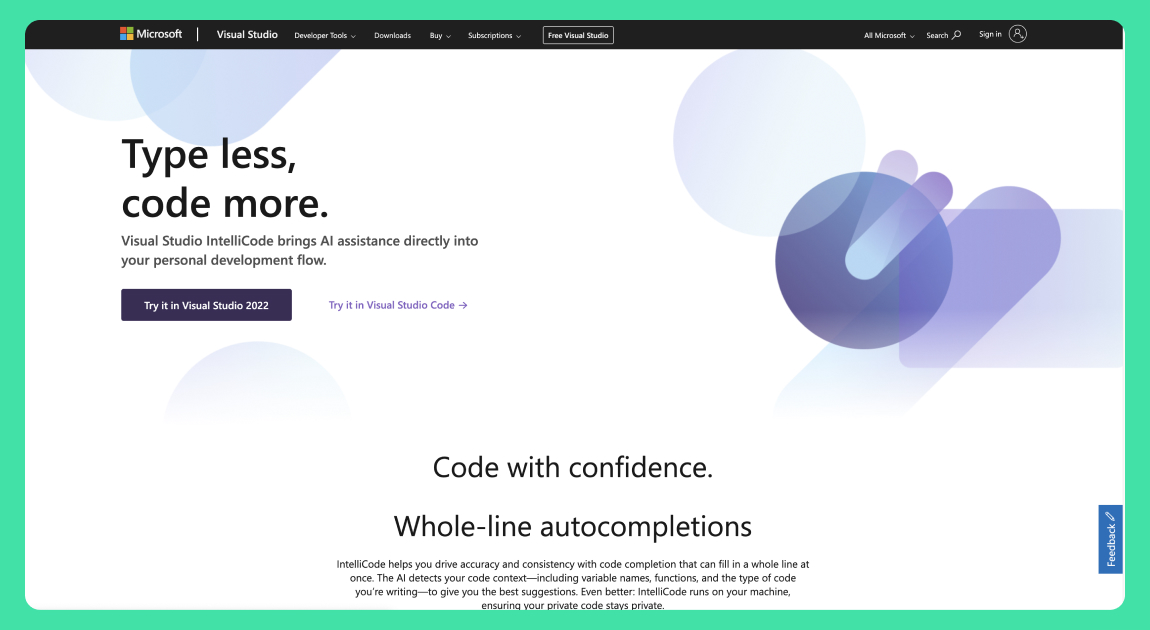
Industry best practices – Applies common coding patterns from training on thousands of open-source projects, offering suggestions that align with best practices observed across the industry.
Team completions – Learns from a team's codebase to make suggestions tailored not just to the language but to the team's coding style and patterns, helping to maintain consistency across a project.
3. IntelliJ IDEA by JetBrains

Smart code navigation – Offers advanced refactoring tools that are deeply integrated with its smart code navigation features, allowing developers to safely make broad structural changes to code while ensuring that all references and dependencies are correctly updated.
Context-specific refactoring – Provides context-specific refactoring options based on the language, framework, and even the current state of the code, ranging from simple variable renames to major structural changes.
4. Refact.AI
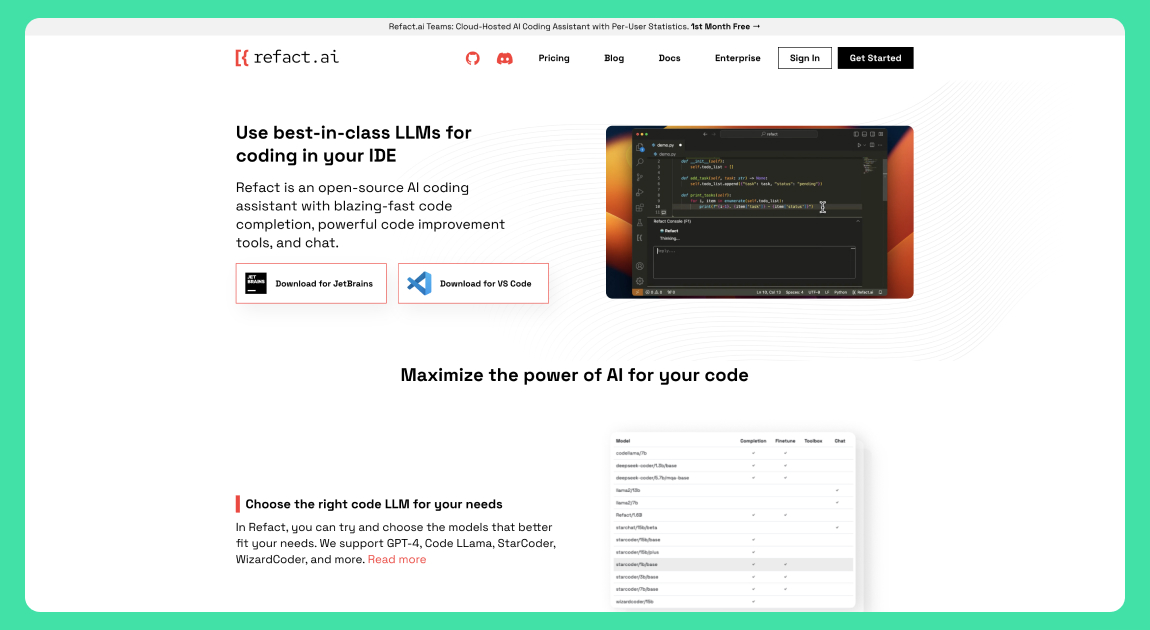
Code smell detection – Uses AI to detect code smells or indicators of deeper problems in the code that may not be immediately obvious. It then offers specific refactoring suggestions to address these issues.
Automated technical debt reduction – Targets technical debt directly with suggestions to reduce future maintenance overhead.
5. Code Scene
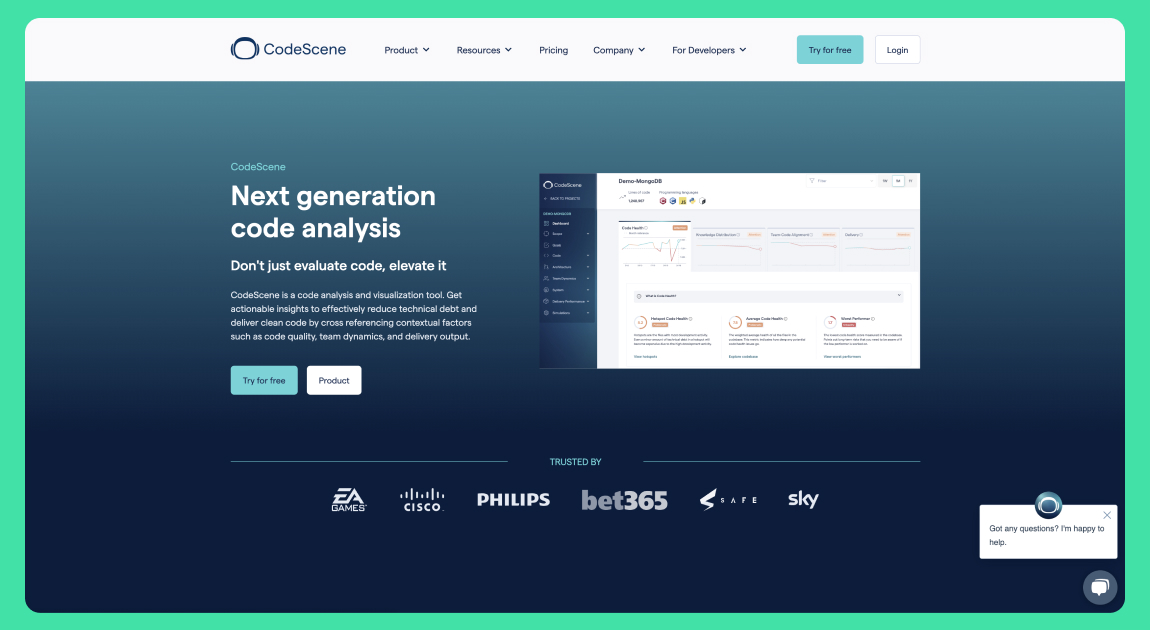
Behavioral code analysis – Differs by offering a behavioral analysis of code, identifying "hotspots" of complex, frequently changed, or error-prone code that could benefit from refactoring. This insight helps prioritize refactoring efforts where they can have the most impact.
Temporal coupling analysis – Identifies files that often change together. This insight can guide refactoring efforts to improve modularity or highlight hidden dependencies.
Continuous integration and deployment (CI/CD) tools
The software development methodology of CI/CD enables developers to integrate code into a shared repository early and often and deploy that code seamlessly to production environments. The addition of artificial intelligence into this framework brings a new level of efficiency — enhancing the software development lifecycle (SDLC) with smart features that automate and optimize many aspects of the development process. Key features include:
Predictive analysis
Using historical data to predict future outcomes, an AI system can identify potential bottlenecks or failures in the integration and deployment process. For example, if updates to critical system dependencies have historically led to deployment issues, AI can flag similar changes for extra review or testing. This allows teams to proactively address issues before they disrupt the development workflow or impact availability in production.
Intelligent test automation
This automation can prioritize and select relevant tests based on the changes made in a code commit, reducing the testing time and ensuring that the most critical aspects of the application are tested thoroughly.
Deployment optimization
By analyzing past deployment data, AI can recommend the best times and methods for deploying new code to minimize downtime and improve the user experience. Furthermore, it can recommend deployment strategies, such as canary releases or blue-green deployments, that best meet the users' needs.
Automated code reviews
This evaluates code against various metrics (trained on high-quality code examples) to assess its quality, including readability, maintainability, and efficiency. Specific areas of the codebase are identified for improvement. The idea is to verify that only high-quality code is pushed forward in the deployment pipeline.
Top 5 AI tools for CI/CD
1. Jenkins X
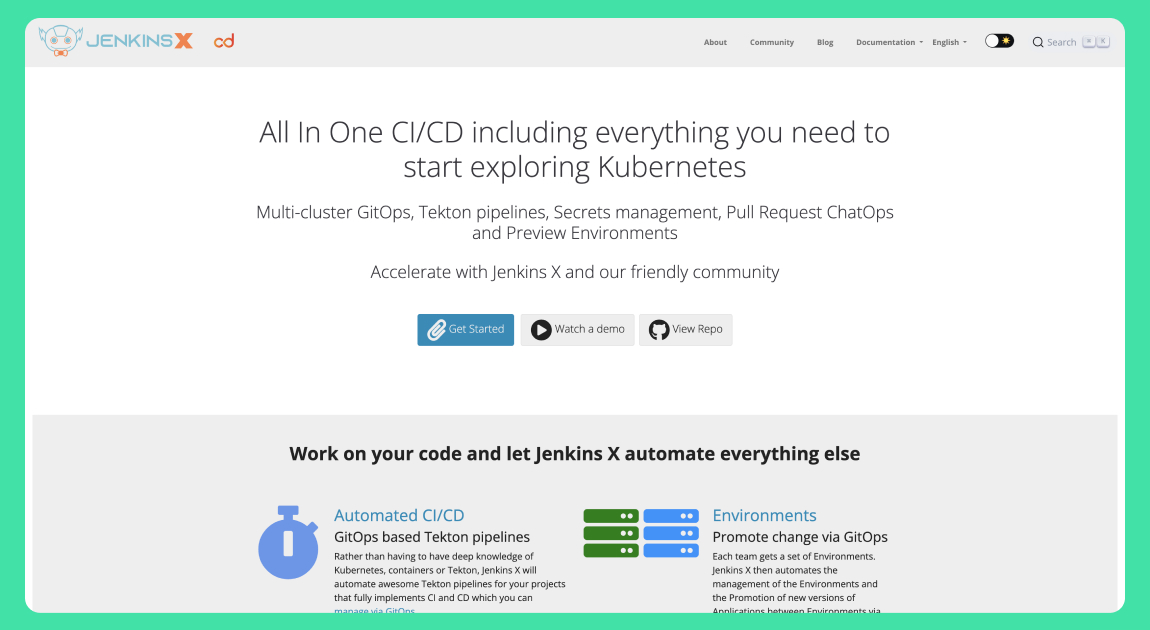
Cloud-native CI/CD – Designed for cloud-native applications on Kubernetes, offering automated CI/CD pipelines that leverage container technology for high efficiency and scalability.
Environment promotion via GitOps – Unique to Jenkins X is its approach to promoting environments through GitOps, where changes to environments are managed through pull requests, integrating code quality checks and deployments into a seamless workflow.
2. CircleCI
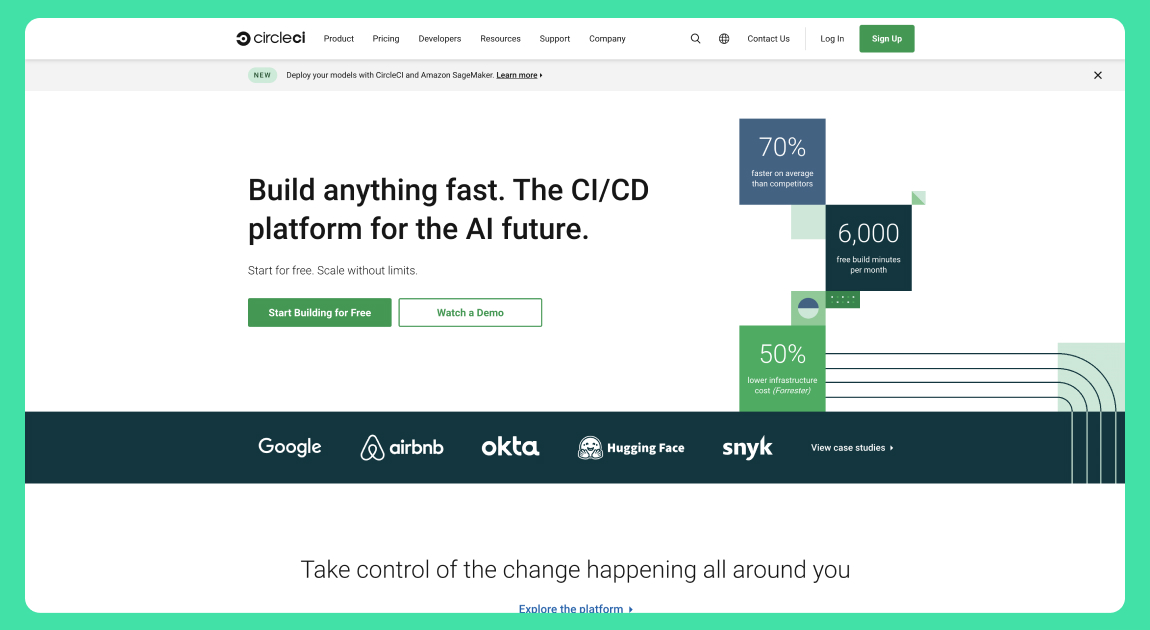
Intelligent orchestration – Uses AI to optimize the build process, intelligently caching dependencies and predicting best test-splitting strategies to minimize build times while ensuring thorough testing.
Configurable parallelism – Allows developers to adjust the number of containers used for tests and deployments, optimizing resource utilization based on the complexity of the task and the codebase.
3. Harness

Deployment verification – Its Continuous Verification feature uses unsupervised machine learning to automatically verify deployments by analyzing time-series metrics, logs, and traces. It can identify anomalies and potentially problematic deployments without human intervention.
Smart automation of rollbacks – Can automatically roll back failing deployments, leveraging AI to detect issues early and minimize downtime.
4. GitLab CI/CD
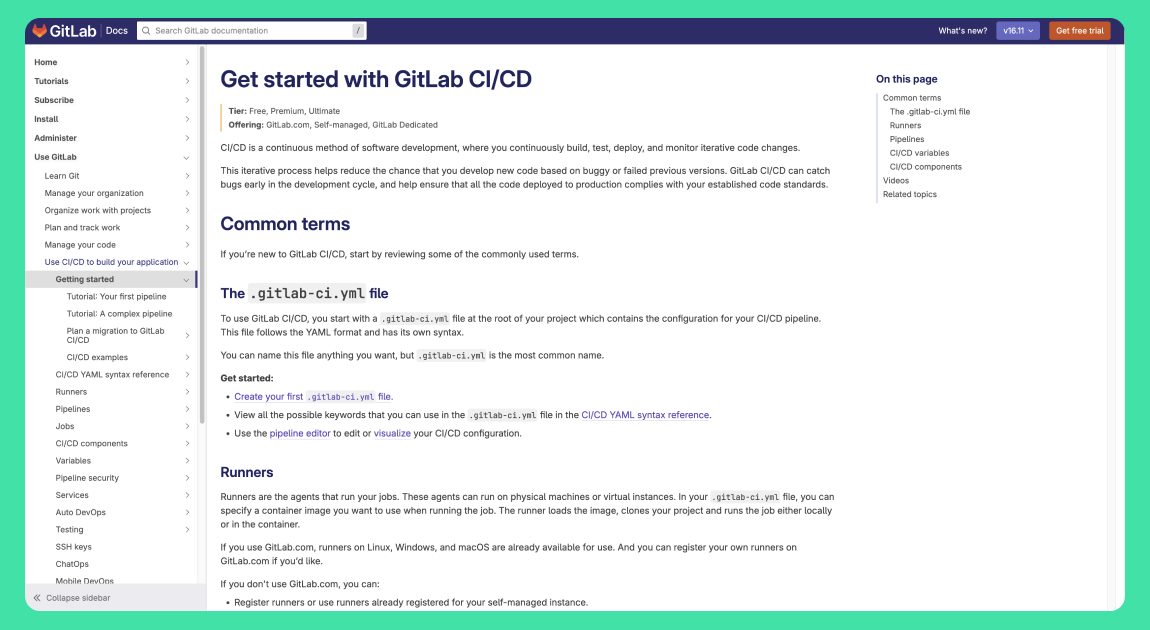
Integrated DevOps platform – A single application for the entire software development and deployment process. Code quality, security scanning, and performance metrics are all part of the merge request process, allowing for immediate feedback and optimization suggestions.
Auto DevOps – Automatically detects, builds, tests, deploys, and monitors applications, leveraging predefined CI/CD configurations, which can significantly reduce manual configuration and oversight.
5. TravisCI
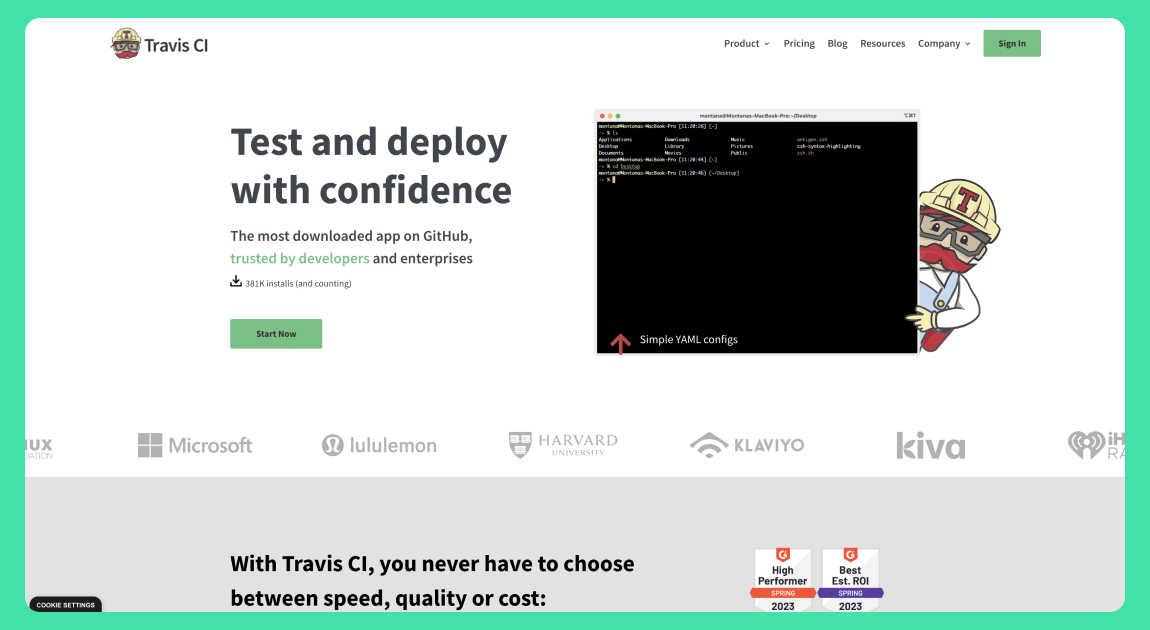
Open source and community-driven – Has a strong open-source community, offering community-contributed documentation and configurations that help set up sophisticated CI/CD pipelines with ease.
Multi-OS support – Provides support for multiple operating systems, including Linux, macOS, and Windows, allowing for cross-platform builds and tests, essential for projects targeting multiple environments.
Code security and compliance tools
With cyber threats becoming more sophisticated and regulations around data privacy and security tightening, developers face increasing pressure to ensure their codebase is secure and compliant with industry standards. For many developers, this is out of the scope of their original training. AI tools fill this knowledge gap, helping developers create secure applications that can survive the hostile threat landscape. Key features include:
Automated vulnerability scanning and detection
By leveraging machine learning algorithms trained on vast datasets of known vulnerabilities, these tools can scan codebases for patterns and anomalies that indicate security vulnerabilities. This proactive identification helps developers address risks early in the development cycle, significantly reducing the chance that a vulnerability makes it to production.
Configuration scanning
When applications are deployed across various platforms and environments, finding the optimal configuration settings is critical for security, performance, and reliability. Misconfigurations can lead to significant vulnerabilities, making systems easy targets for cyber attacks. AI-powered tools can scan configuration states across various environments – cloud, on-premise, and hybrid – to identify deviations from configuration best practices.
Compliance verification
Manual compliance verification is a time-consuming and daunting task when considering the many legal and regulatory requirements surrounding modern software. AI tools simplify this process by automatically checking the code against compliance standards and guidelines. Whether it's GDPR, HIPAA, or industry-specific regulations, AI can help get the team ready for compliance audits.
SAST and DAST
Integrating AI into static application security testing (SAST) and dynamic application security testing (DAST) can offer a more accurate and comprehensive analysis. AI algorithms reduce false positives and adapt to the unique context of the application, providing developers with actionable insights and recommendations for securing their code.
Security risk prioritization
Not all vulnerabilities pose the same level of risk to an application. AI-powered tools can assess the severity and potential impact of vulnerabilities identified by the scanning process, prioritizing them so developers can implement controls for the most critical issues first. This risk-based approach ensures that resources are allocated effectively.
Top 5 AI tools for code security and compliance
1. Snyk
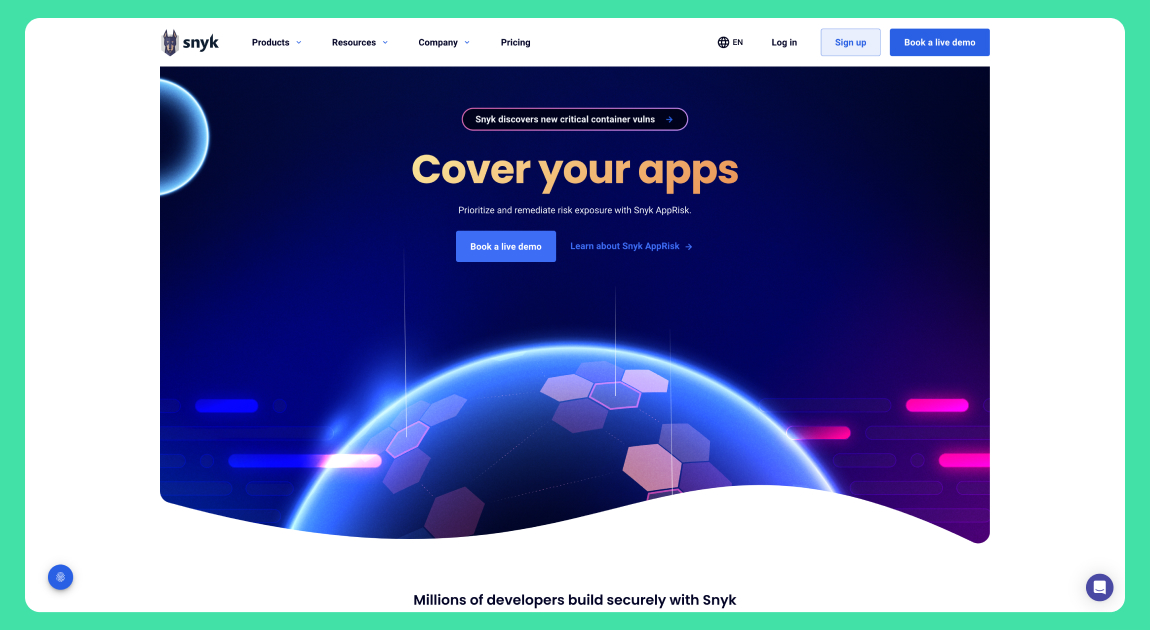
Developer-focused security – Designed with developers in mind, making it easier to integrate security into the development process from the start. Its seamless integration with development environments and CI/CD pipelines enables early detection and remediation of vulnerabilities.
Open-source vulnerability database – Uses an extensive, constantly updated database of open-source vulnerabilities, allowing it to scan dependencies for known security issues and offer precise remediation advice.
2. Jit
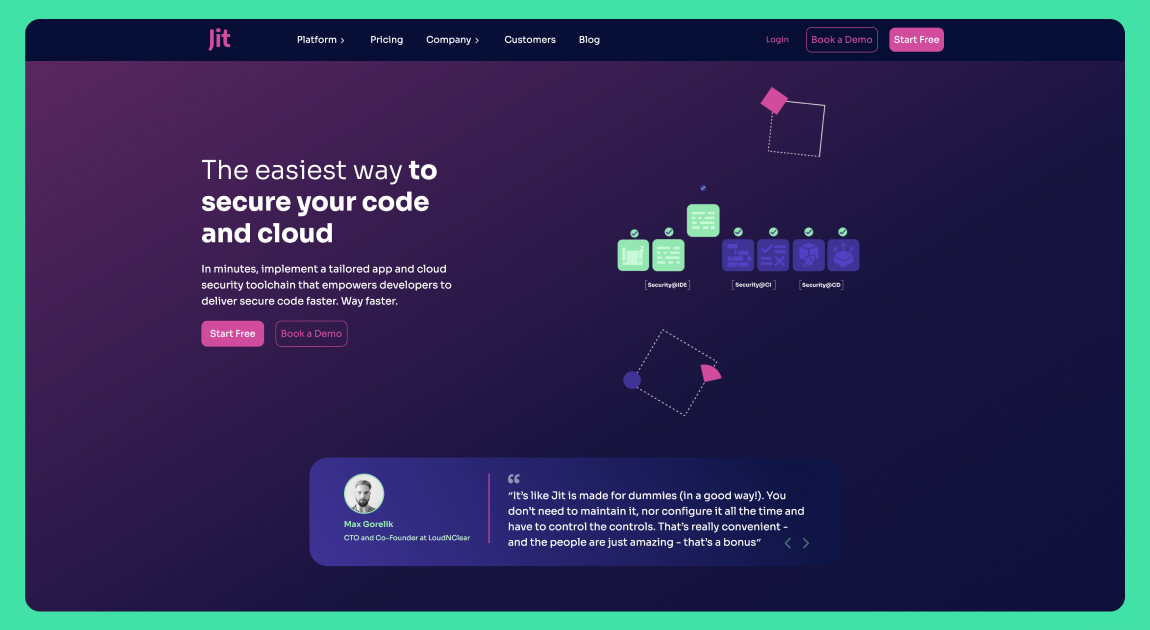
End-to-end security platform – Offers a comprehensive security solution that covers code, dependencies, and infrastructure. Automatically runs security checks on pull requests within GitHub and creates comments for flagged findings with remediation suggestions.
Customizable security workflows – Allows teams to customize their security workflows, ensuring that security practices align with their development cycle and organizational needs.
3. Veracode
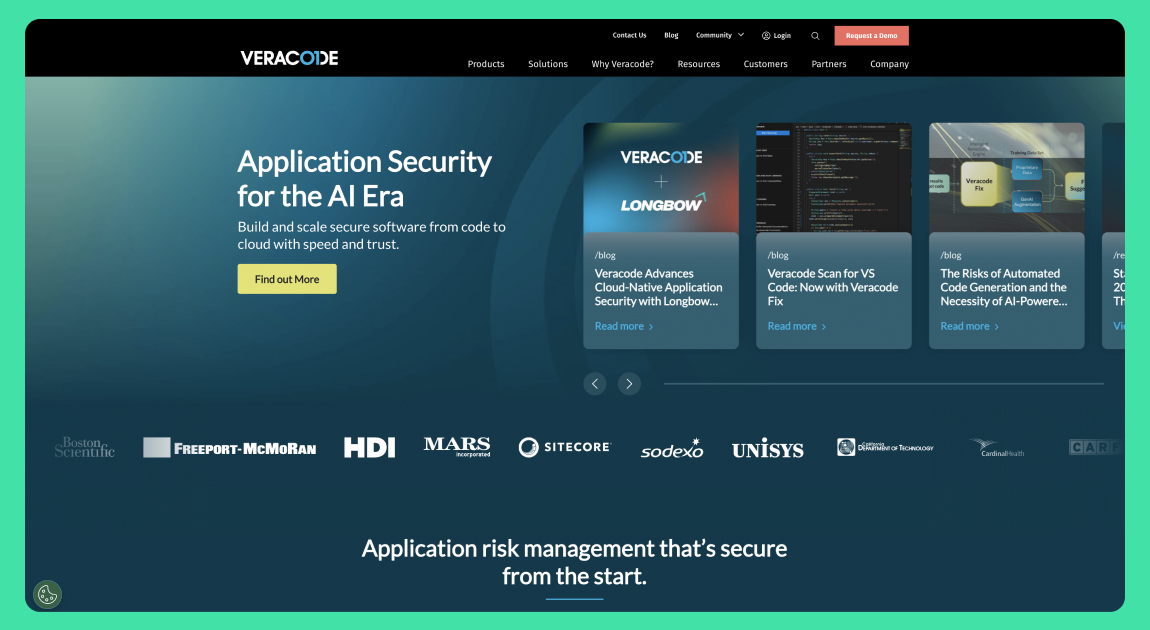
Integrated application security – Combines SAST, DAST, software composition analysis (SCA), and manual penetration testing in one platform. This integration offers a thorough security posture assessment at every stage of the software development lifecycle.
Enhanced learning tools – Provides developers with educational resources directly related to identified issues, facilitating better understanding and more effective remediation.
4. OpenText Fortify
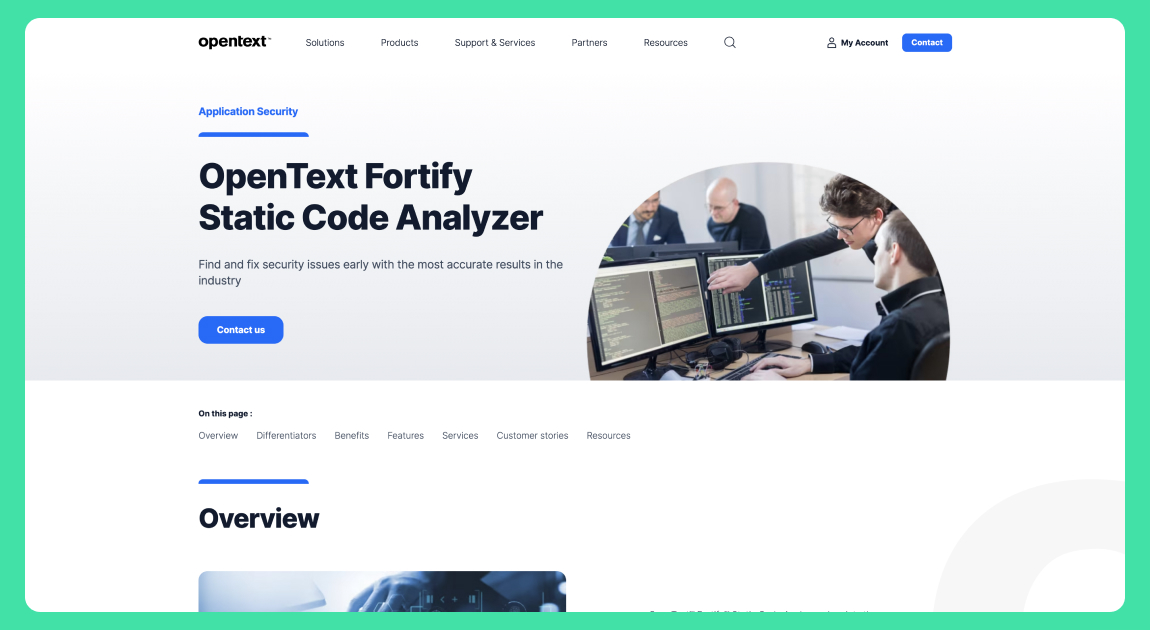
Comprehensive SAST – Offers static dynamic application security testing for 1,657 vulnerability categories, equipped with advanced AI algorithms to reduce false positives and prioritize threats based on the application's unique context.
Security assistant for real-time feedback – Offers real-time, as-you-code advice for developers, making it easier to write secure code from the outset without compromising development speed.
5. Checkmarx
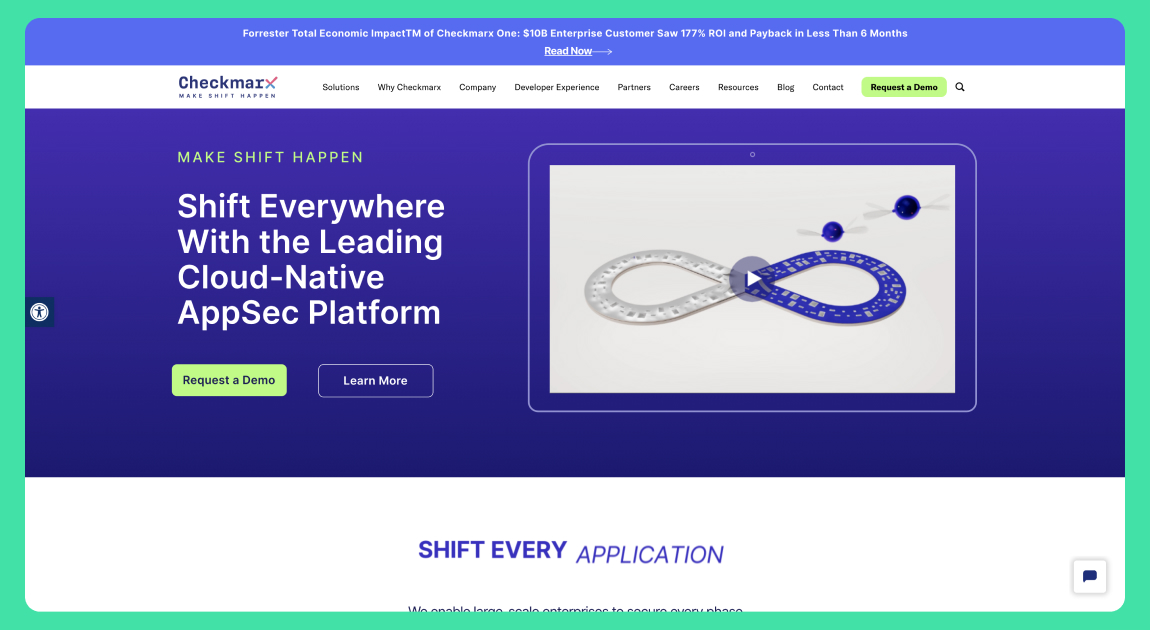
Best-in-class SAST – Renowned for its powerful static application security testing engine that can scan uncompiled/unbuilt code for early-stage testing.
Custom query language for tailored scanning – Offers a unique query language that allows teams to customize scanning rules based on their specific security policies and threat models.
Text Platform – The all-in-one solution
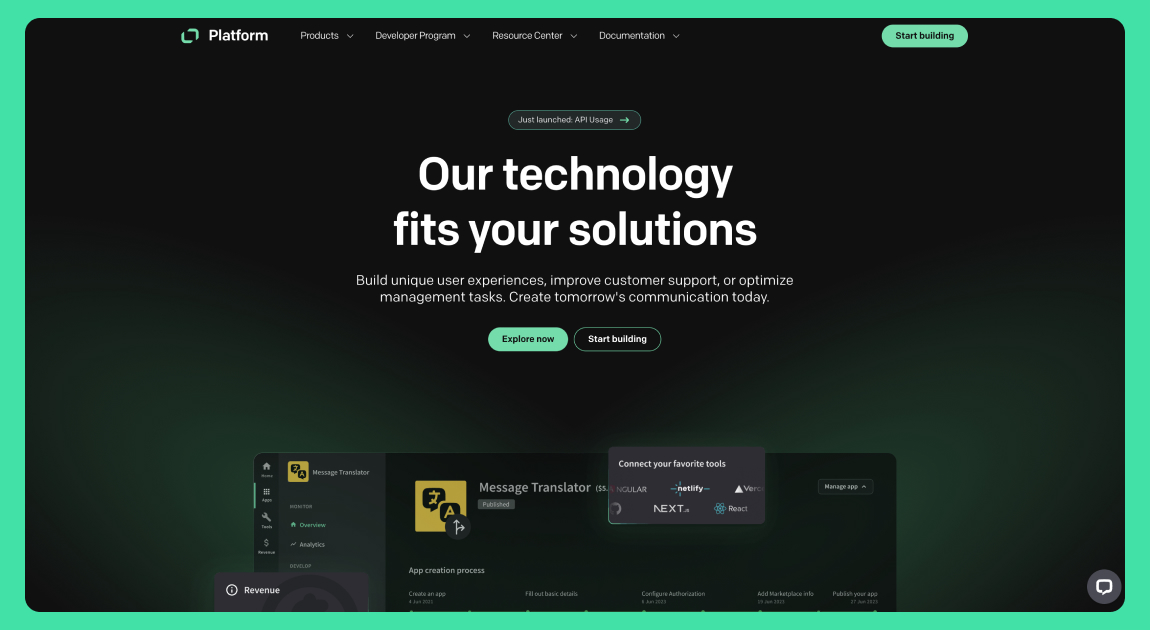
The Text Platform is a comprehensive solution for developers building applications for LiveChat or HelpDesk systems.
AI assistants can be integrated directly into your development environment, allowing you to streamline your coding process while working with the Text Platform's APIs and SDKs. This can be useful when developing chat messaging solutions, generating reports, or configuring settings for your LiveChat and HelpDesk solutions.
Text Platform developers can also use natural language processing tools to beef up the chat messaging features of LiveChat, creating more intuitive and human-like interactions. These tools can generate dynamic content for reports or configure complex settings without needing to write extensive code.
Integrating AI-driven CI/CD tools with the Text Platform can further enhance the development workflow. Updates and new features can be rolled out quickly and efficiently with minimal downtime.


